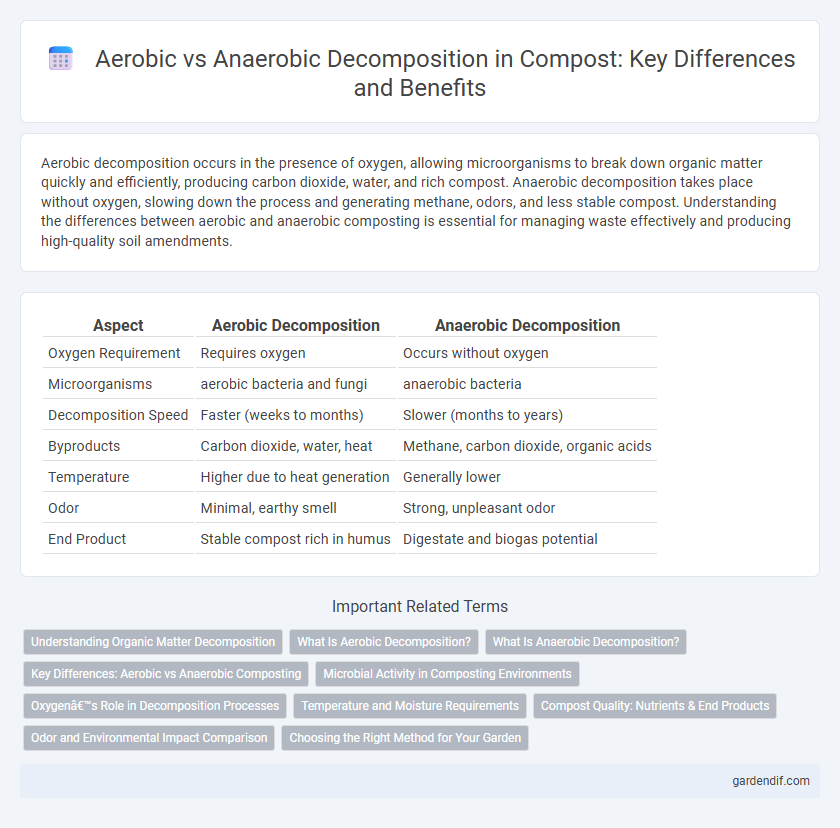
Aerobic vs Anaerobic Decomposition Illustration
Aerobic decomposition occurs in the presence of oxygen, allowing microorganisms to break down organic matter quickly and efficiently, producing carbon dioxide, water, and rich compost. Anaerobic decomposition takes place without oxygen, slowing down the process and generating methane, odors, and less stable compost. Understanding the differences between aerobic and anaerobic composting is essential for managing waste effectively and producing high-quality soil amendments.
Table of Comparison
| Aspect | Aerobic Decomposition | Anaerobic Decomposition |
|---|---|---|
| Oxygen Requirement | Requires oxygen | Occurs without oxygen |
| Microorganisms | aerobic bacteria and fungi | anaerobic bacteria |
| Decomposition Speed | Faster (weeks to months) | Slower (months to years) |
| Byproducts | Carbon dioxide, water, heat | Methane, carbon dioxide, organic acids |
| Temperature | Higher due to heat generation | Generally lower |
| Odor | Minimal, earthy smell | Strong, unpleasant odor |
| End Product | Stable compost rich in humus | Digestate and biogas potential |
Understanding Organic Matter Decomposition
Aerobic decomposition occurs in the presence of oxygen, allowing microorganisms to efficiently break down organic matter into carbon dioxide, water, and nutrient-rich humus, which enhances soil fertility. Anaerobic decomposition takes place without oxygen, producing methane, ammonia, and other gases that can contribute to greenhouse gas emissions and slower nutrient cycling. Understanding the differences between these processes is crucial for optimizing composting methods to improve organic matter decomposition and minimize environmental impact.
What Is Aerobic Decomposition?
Aerobic decomposition is the process by which organic waste is broken down by microorganisms in the presence of oxygen, producing carbon dioxide, water, and nutrient-rich compost. This type of decomposition is faster and less odorous compared to anaerobic decomposition, which occurs without oxygen and generates methane and other gases. Maintaining proper aeration and moisture levels is essential to optimize aerobic decomposition for efficient composting.
What Is Anaerobic Decomposition?
Anaerobic decomposition occurs in environments lacking oxygen where microorganisms break down organic matter, producing methane, carbon dioxide, and other gases. This process is slower than aerobic decomposition and often results in unpleasant odors due to the release of compounds like hydrogen sulfide. Anaerobic decomposition is common in landfills and waterlogged soils, where oxygen diffusion is limited.
Key Differences: Aerobic vs Anaerobic Composting
Aerobic composting relies on oxygen to break down organic material, producing carbon dioxide, water, and heat, which speeds up decomposition and results in nutrient-rich compost. Anaerobic composting occurs without oxygen, leading to slower breakdown and the production of methane and other greenhouse gases, often causing unpleasant odors. Key differences include oxygen presence, decomposition speed, gas emissions, and odor intensity, affecting compost quality and environmental impact.
Microbial Activity in Composting Environments
Aerobic decomposition relies on oxygen-consuming microbes such as bacteria and fungi that efficiently break down organic matter into nutrient-rich compost, producing carbon dioxide, heat, and water as byproducts. Anaerobic decomposition occurs in oxygen-deprived environments where facultative and obligate anaerobic microbes generate methane and other gases, often resulting in slower decomposition and unpleasant odors. Microbial activity in aerobic composting accelerates organic matter stabilization and enhances soil amendment quality by promoting diverse microbial populations that thrive in oxygen-rich conditions.
Oxygen’s Role in Decomposition Processes
Oxygen plays a crucial role in aerobic decomposition by enabling microorganisms to break down organic matter efficiently, resulting in faster composting and minimal odor. In contrast, anaerobic decomposition occurs in the absence of oxygen, leading to slower breakdown processes and the production of methane and foul-smelling gases. Maintaining proper aeration in compost piles optimizes oxygen availability, promoting aerobic activity and enhancing nutrient-rich humus formation.
Temperature and Moisture Requirements
Aerobic decomposition requires temperatures between 135degF and 160degF to effectively break down organic materials while maintaining moisture levels around 40-60% for optimal microbial activity. Anaerobic decomposition occurs at lower temperatures, often below 100degF, and thrives in water-saturated environments exceeding 70% moisture, which limits oxygen availability. Proper temperature and moisture management in composting ensures efficient organic matter breakdown and prevents foul odors.
Compost Quality: Nutrients & End Products
Aerobic decomposition produces nutrient-rich compost with balanced nitrogen, phosphorus, and potassium levels, enhancing soil fertility and structure. In contrast, anaerobic decomposition yields compost with lower nutrient availability and often results in methane and hydrogen sulfide emissions, which can harm soil health. High-quality compost from aerobic processes supports robust plant growth and improves long-term soil productivity.
Odor and Environmental Impact Comparison
Aerobic decomposition produces minimal odor and releases primarily carbon dioxide and water, making it environmentally favorable by reducing methane emissions. Anaerobic decomposition generates strong, unpleasant odors due to gases like hydrogen sulfide and methane, contributing significantly to greenhouse gas emissions. Efficient composting systems prioritize aerobic conditions to minimize odor and environmental impact, promoting sustainable waste management.
Choosing the Right Method for Your Garden
Aerobic decomposition relies on oxygen to break down organic matter, producing nutrient-rich compost faster and with less odor, making it ideal for most home gardens. Anaerobic decomposition occurs without oxygen, often producing methane and strong odors, and is better suited for managing large volumes of wet or dense organic waste. Selecting aerobic composting enhances soil health and plant growth by supplying well-balanced nutrients and improving aeration in garden beds.
Aerobic vs Anaerobic Decomposition Infographic

 gardendif.com
gardendif.com